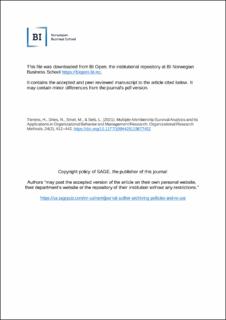| dc.contributor.author | Tierens, Hans | |
| dc.contributor.author | Smets, Mike | |
| dc.contributor.author | Sels, Luc | |
| dc.contributor.author | Dries, Nicky | |
| dc.date.accessioned | 2021-04-26T10:45:54Z | |
| dc.date.available | 2021-04-26T10:45:54Z | |
| dc.date.created | 2020-01-09T19:17:09Z | |
| dc.date.issued | 2019 | |
| dc.identifier.citation | Organizational Research Methods, 2019, 24 (2), 412–442. | en_US |
| dc.identifier.issn | 1094-4281 | |
| dc.identifier.uri | https://hdl.handle.net/11250/2739540 | |
| dc.description.abstract | Multilevel paradigms have permeated organizational research in recent years, greatly advancing our understanding of organizational behavior and management decisions. Despite the advancements made in multilevel modeling, taking into account complex hierarchical structures in data remains challenging. This is particularly the case for models used for predicting the occurrence and timing of events and decisions—often referred to as survival models. In this study, the authors construct a multilevel survival model that takes into account subjects being nested in multiple environments—known as a multiple-membership structure. Through this article, the authors provide a step-by-step guide to building a multiple-membership survival model, illustrating each step with an application on a real-life, large-scale, archival data set. Easy-to-use R code is provided for each model-building step. The article concludes with an illustration of potential applications of the model to answer alternative research questions in the organizational behavior and management fields. | en_US |
| dc.language.iso | eng | en_US |
| dc.publisher | Sage | en_US |
| dc.subject | Multilevel | en_US |
| dc.subject | Multiple membership | en_US |
| dc.subject | Survival analysis | en_US |
| dc.subject | Early-career turnover | en_US |
| dc.title | Multiple-membership survival analysis and its applications in organizational behavior and management research | en_US |
| dc.type | Journal article | en_US |
| dc.type | Peer reviewed | en_US |
| dc.description.version | acceptedVersion | en_US |
| dc.source.pagenumber | 412-442 | en_US |
| dc.source.volume | 24 | en_US |
| dc.source.journal | Organizational Research Methods | en_US |
| dc.source.issue | 4 | en_US |
| dc.identifier.doi | 10.1177/1094428119877452 | |
| dc.identifier.cristin | 1769836 | |
| cristin.unitcode | 158,4,0,0 | |
| cristin.unitname | Institutt for ledelse og organisasjon | |
| cristin.ispublished | false | |
| cristin.fulltext | postprint | |
| cristin.qualitycode | 2 | |
